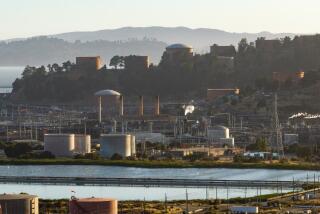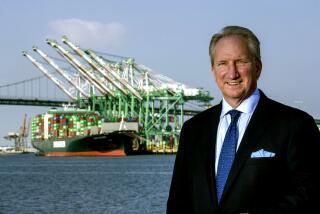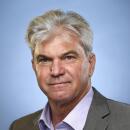On Beating Swords Into Trade Centers
- Share via
SAN BERNARDINO — With the noon sun high over the mountains, lush orange groves color the far reaches of the city. Tree-lined streets and promenades bustle with Research and Development companies. The pretty avenues and redesigned roadways all lead up to a state-of-the-art World Trade Center at the foot of the Airport.
--From a brochure promoting the conversion of Norton Air Force Base to civilian usage
*
The sun was high over the mountains. Somewhere. The smog, blown in from Los Angeles, was blocking it out. “There’s a mountain right over there,” Bill Boph said, pointing toward a wall of gray haze. “You can’t see it today, but in the winter it’s beautiful.”
He drove toward the faded remains of Norton Air Force Base, on streets lined, not with glittering towers of R-and-D, but with shacks and burger joints. These roads did not lead to a World Trade Center, because its private promoter had yet to line up investors. The airport was open, but the tower and terminal were not. Still, Boph was enthusiastic.
“We are on the climb,” he said.
“We are coming out of the bottom of the curve.”
Before he was hired to direct the Norton reuse agency, this amiable, 61-year-old man in the tan suit had toiled in real estate, as the perceptive reader might have guessed. Pessimists don’t last long in real estate or either, it turns out, in the business of base conversions--”our No. 1 growth industry,” as Boph called it.
*
Norton was selected for closure in 1988, a few years ahead of most California bases currently under conversion. As a result, the work of Boph and his cohorts has been closely watched. They are the trailblazers hacking toward the promised land or, for those not in real estate, the canaries down in the mine shaft. About every difficulty he has encountered--lawsuits, “false starts,” toxic surprises, frustrating negotiations with the feds--most likely will be experienced at the other base sites.
In some ways, the test faced by Boph and Co. seems tougher than most. This is not the naval base on Treasure Island, with its priceless, panoramic views of San Francisco Bay. Or El Toro, positioned for inevitable boom at the confluence of Southern California’s two great north-south freeways. Or Ft. Ord, with its sprawl of beachside bluffs overlooking Monterey Bay. This is Norton, surrounded by blighted neighborhoods in old San Berdoo.
Ft. Ord captured attention with its rapid creation of a state university. “We would have loved that,” said Boph, “but no university came and beat on our door.” Subdividers also stayed away. Prison officials did express interest; it was not reciprocated. Lockheed made a brief run at a maintenance facility. And there were many dreamers: “Guys with big ideas but without two nickels to rub together.”
One entrepreneur envisioned a snow mountain inside a hangar, for year-round winter sport. Another saw in the NCO club an opportunity to reinvent the dining experience: “I guess,” Boph said, driving past the now vacant Hollywood East restaurant, “he remembered what it was like when a captive audience was here. Nobody came.”
*
The decision was to go for an international airport, with a focus on air freight, surrounded by a trade center, light industry, offices and golf course. Or so went the plans, so fetchingly rendered in the brochures. So far, the abandoned base looks exactly like an abandoned air base. Weeds sprout through the asphalt. Wind whistles through the dilapidated, beige barracks. Bring your contractor, as the real estate come-on puts it.
The dismal appearance is at least a bit deceptive. With hard sell and soft rent--and despite the lack of a central, trophy tenant--Boph has cobbled together a community of fledgling businesses. The range runs from a missile company to a Christian limo service, and together these firms represent almost 3,000 new jobs.
Boph estimates that within seven years the conversion project will have recovered all 7,500 of the jobs lost to closure. This is about twice as fast as predicted, but not nearly fast enough to satisfy those critics in town who saw the base as “this great golden thing,” ripe for overnight success. Time and patience, preached Tolstoy’s old general, who would have found an ally in one Bill Boph.
He ended the tour off the base, at a sparkling development of mirrored office buildings and new chain restaurants. The scene, decorated with German sedans and lush landscaping, could have been ripped from one of Boph’s brochures. “This is the dream,” he said, stopping his van. “I won’t be around to see it, but this is the objective. It could happen. It will happen.” This business park was only about a mile from the base, a long mile.
More to Read
Inside the business of entertainment
The Wide Shot brings you news, analysis and insights on everything from streaming wars to production — and what it all means for the future.
You may occasionally receive promotional content from the Los Angeles Times.











